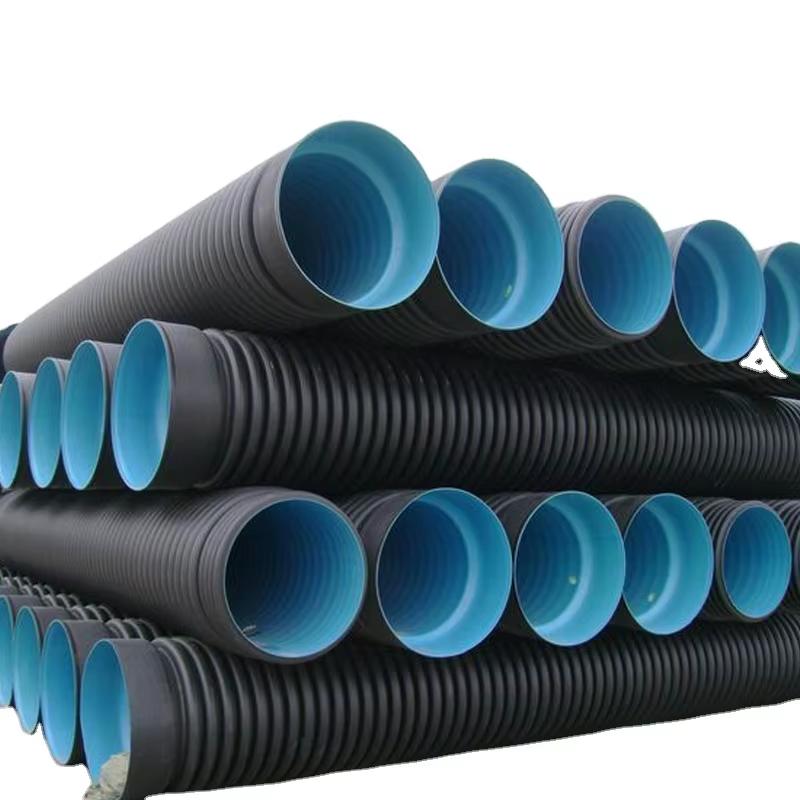Double-Walled Sewer Pipes
Double-walled sewer pipes are among the most widely used types of pipes in systems for wastewater and surface water transfer. These pipes are typically made of polyethylene and are utilized in various construction, industrial, and urban projects due to their unique properties.
Features of Double-Walled Sewer Pipes:
Structure:
- Composed of two layers:
- Outer Layer: Usually black or orange, with a corrugated structure to enhance mechanical strength.
- Inner Layer: Smooth and slippery, typically in light colors (e.g., white, yellow, or blue) to facilitate flow and reduce friction.
High Durability:
- Excellent resistance to external pressures (e.g., soil load or traffic).
- Resistant to chemicals and corrosive substances.
Lightweight:
- Easy to transport and install due to its light weight.
Long Lifespan:
- High resistance to environmental factors, with a lifespan of over 50 years in most cases.
Leakproof:
- Special fittings (e.g., gaskets or couplers) minimize leakage risks.
Eco-Friendly:
- Recyclable and environmentally friendly.
Applications of Double-Walled Sewer Pipes:
- Urban and rural sewage systems.
- Collection and management of surface water.
- Agricultural drainage systems.
- Non-corrosive industrial fluid transfer.
Available Sizes:
Double-walled pipes are manufactured in a range of sizes from 100 mm to 3000 mm, selected based on project requirements.
Key Points for Purchasing:
- Verify production standards (e.g., ISO or INSO standards).
- Pay attention to the ring stiffness class (SN4, SN8, or higher).
- Choose the appropriate size based on the desired flow rate.
- Ensure the quality of fittings and accessories.
Advantages of Using Double-Walled Sewer Pipes:
Cost Efficiency:
- Lighter weight makes transport and installation easier and cheaper compared to metal or concrete pipes.
- Reduced need for heavy equipment during installation lowers operational costs.
Environmental Resistance:
- Resistant to temperature changes, freezing, and UV radiation.
- Unaffected by moisture and corrosion.
Ease of Maintenance:
- Smooth internal surfaces minimize blockages and sediment buildup.
- Damaged sections can be easily repaired or replaced.
Design Versatility:
- Available in various lengths (typically 6 or 12 meters) and shapes (e.g., spiral or corrugated pipes).
- High flexibility for use in both underground and surface projects.
Eco-Friendliness:
- Polyethylene raw materials are recyclable, contributing to reduced environmental impact.
- Minimizing leakage prevents contamination of groundwater sources.
Disadvantages of Double-Walled Sewer Pipes:
While these pipes offer numerous advantages, certain limitations may exist:
Sensitivity to High Temperatures:
- Although temperature-resistant, they may not be suitable for transferring fluids exceeding 60-70°C.
Specialized Fittings Required:
- Installation may require specific fittings like couplers, gaskets, or polyethylene welding equipment.
Limitations in Specific Conditions:
- For projects requiring exceptional resistance to internal pressure or high temperatures, metal or concrete pipes may be more appropriate.
Technical Considerations for Installation:
Site Preparation:
- Careful excavation to prevent pipe damage and ensure proper slope for flow.
Proper Bedding:
- Use of sand or non-corrosive materials as a base.
Accurate Connections:
- Use of standard couplers and gaskets to prevent leaks.
Backfilling:
- Surrounding the pipe with suitable materials and compacting them correctly to prevent deformation.
Quality Control:
- Inspect thoroughly for leaks and confirm slope alignment before complete burial.
Comparison with Other Pipes:
| Feature | Double-Walled Sewer Pipes | Concrete Pipes | Metal Pipes (Galvanized) |
|---|---|---|---|
| Weight | Light | Heavy | Medium |
| Corrosion Resistance | Very High | Low | Medium |
| Installation & Transport | Easy | Difficult | Medium |
| Lifespan | High (50+ years) | Medium (20-30 years) | Low (10-20 years) |
| Chemical Resistance | Very High | Low | Medium |
Production Steps of Double-Walled Sewer Pipes:
- Material Preparation:
- Use of high-density polyethylene (HDPE) as the primary material.
- Addition of UV stabilizers, antioxidants, and other additives to enhance durability and lifespan.
- Extrusion:
- Raw materials are fed into an extruder and melted at high temperatures.
- The melted materials are simultaneously shaped into the inner and outer layers.
- Outer Layer Formation:
- The outer layer is corrugated or ribbed to increase mechanical strength.
- Inner Layer Creation:
- The inner layer is made smooth to reduce friction and facilitate fluid flow.
- Layer Bonding:
- The inner and outer layers are fused together during the production process.
- Cooling:
- The pipes pass through cooling tanks to stabilize their final shape.
- Cutting and Packaging:
- Pipes are cut into standard lengths (typically 6 or 12 meters) and packaged.
Cost Calculation and Economic Benefits:
Using double-walled sewer pipes often reduces overall project costs. Key considerations include:
Purchase Costs:
- Determined by factors such as:
- Pipe size and diameter (100 mm to 3000 mm).
- Ring stiffness class (SN4, SN8, or higher).
- Manufacturer’s brand.
Transportation Costs:
- Lighter weight makes transportation more affordable compared to concrete or metal pipes.
Installation Costs:
- Simple installation and reduced reliance on heavy equipment lower installation expenses.
Long Lifespan:
- High durability minimizes maintenance and repair costs in the long term.
Major Projects Using Double-Walled Sewer Pipes:
These pipes have been employed in various projects across Iran and other countries:
- Urban Sewer Systems: Collection and transfer of wastewater in large cities.
- Agricultural Drainage: Used in farmlands to manage excess water.
- Industrial Projects: Transport of chemical and industrial wastewater resistant to corrosion.
- Infrastructure Projects: Collection of rainwater and surface water in highways and tunnels.
Final Recommendations:
Appropriate Selection:
- Choose based on project needs, resistance class, size, and production standards.
Accurate Installation:
- Engage professional installers and adhere to standards to maximize system longevity.
Regular Maintenance:
- Periodic inspections and ensuring no blockages or damage can reduce potential costs.
Our company is a leading producer, exporter, and service provider of various double-walled sewer pipes in the Middle East. For more information, feel free to contact our team.

